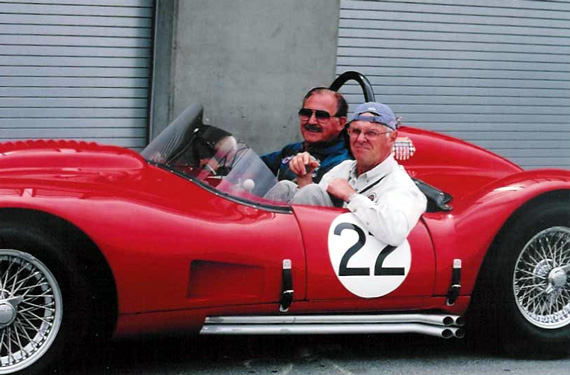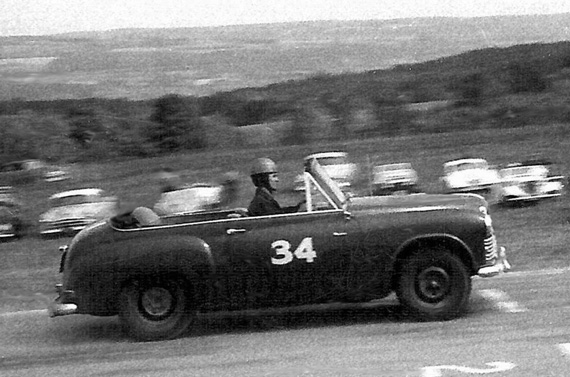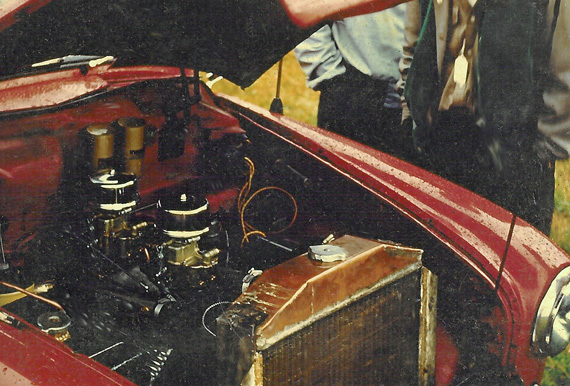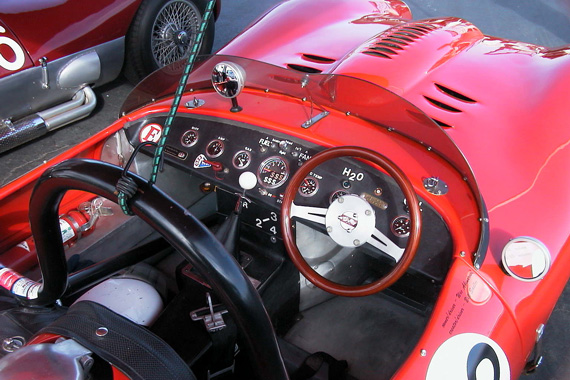Story and photos by John Wright
John Wright has been around the bend several times now and has written widely for a number of magazines including Vintage RaceCar. He also contributed the recent article in VeloceToday about the Campion Lancia S4.
Bill Sadler is like the proverbial iceberg, nine tenths of him lies below the surface. Although many old time racers and enthusiasts remember him from his fearsome Sadler Mark II, Mark III and Formula Libre racers and the revolutionary mid-engined Sadler Mark V race cars, not many know that this man took his engineering degree in 2 ½ years and won a full scholarship to MIT. He graduated from that prestigious school with a Masters in Electronic Engineering and went to work for General Dynamics in the msyterious Area 51. He went on to design and fly a light ground attack aircraft for the Turkish Airforce (cancelled after a change in government) and he retired to Oregon.
However, he still races while now in his eighties. He raced a Sadler Formula Junior in the Monterey Historics in 2014 and in 2015 at the Historics raced a recreation of his own Sadler Mark III which he built in his garage in Oregon.
Bill grew up in a family closely associated with the automobile industry. His parents ran Sadler Auto Electric in St Catherines Ontario having moved there from the province of Manitoba. Bill starting working there early in his working life and became an experienced repairer of automobile instruments.
A natural innovator
In the late 1940s, he persuaded his parents to give a 1939 Austin Bantam truck which they were going to scrap and Bill converted it to a roadster by dint of removing the roof and converting it to some kind of a hot rod. He made a convertible top which he stitched together with his mother’s sewing machine. At that time, Bill told me, it was fashionable and advanced to have the shift lever on the steering column. He converted the floor shift on the Bantam by casting an aluminum bracket made from scrap aluminum. He told me the old Bantam was a fun car to drive even though he had diminished the structural integrity of the panel truck by cutting so much metal out of the body. However, he drove the car all over Ontario and into New York.
After that, Bill was of an age where he was earning more money at the shop and so he bought himself a Hillman convertible but the car had an anemic four cylinder engine. It just wasn’t fast enough. He surveyed the engine compartment and determined that a 2.5 liter Ford V-8 “60” engine would fit. But, that little Ford flathead just wasn’t quite enough and so two Stromberg 97 carburetors, the standard hot rod carb of the day made the little Hillman go. Street racing was not enough and so Bill determined that it was time to take the car to the track. What track you say? Why the brand new track on the hill in Watkins Glen. Of course, you drove your car to the track in those days. Well, as Bill put it in a conversation he had with me,” You could hold the brakes of the Hillman in the palm of your hand.” So, braking was a concern.
Bill managed a couple of laps at the new Glen track – leading the race for small bore engines before he ran out of brakes, not a surprising situation. What to do? Why use the hand brake, of course. Some track official noticed this novel way of slowing the Hillman down and he was black flagged. Bill was frustrated. Over the winter, he decided he would design and build his own race car and return to the Glen, which would eventually result in the Sadler Mark I. If the editor will allow, we will get into Bill’s cars in another edition of VeloceToday.
Experiencing Bill Sadler
He’s quite a guy and you saw a rather intimidated me in the Sadler Mark II about to go on the Laguna Seca track in 2005 edition of the Monterey Historics. My experiences with Bill Sadler almost didn’t happen. In 2005 my daughter was going to be married and as you know weddings don’t come cheap. I got a call from an acquaintance by the name of Wes Abendroth. At one time Wes owned the Sadler Mark II, a rare race winning Canadian car. Wes told me I had to come to the Monterey Historics as Bill Sadler was going to be there, I could bunk with Wes, and all it would cost would be my flight down as he would list me as a crew member.
I said I couldn’t do it and reluctantly hung up.
My wife – bless her heart said you should go, as it’s a once in a lifetime opportunity. My daughter’s fiancée, an engineer got on his lap top and found me a cheap Air Canada flight. I called Wes back and told him I was coming.
When I arrived at Laguna Seca, I walked into the paddock and said to myself, Toto, we’re not in Kansas anymore… I found Bill and Wes along with – Chuck Daigh, Billy Krause and got two interviews which covered the cost of the flight, but that’s all…
However, the real payoff took place on the Sunday. That particular year was the celebration of the American-built special and I got to do laps around Laguna Seca with Sadler at the wheel of his Sadler Mark II. It was really NOISY and the wind buffeted me and I couldn’t sit comfortably because the rollbar brace nearly bisected my body but still it was great.
But more later on this enigmatic genius Canadian so stay tuned.




Still fondly remember the sight of Bill Sadler splitting the two Cunningham Lister-Jaguars in the race at Watkins Glen, late ’50s. Being an “underdog”, the crowd was rooting for Sadler.
i met bill sadler very informally–i think–in the spring of ’63 at courtland, alabama where we were feeling out our lancia zagato before taking it to italy. it was an scca race, probably a regional. a gray weekend. the sadler that their team was checking out had sorta a twin-pontoon-looking front, with the headlights in the very front of the fenders. it had a 2-speed gearbox, i was told. seemed like they were using the whole event for shakedown and testing because they were in and out of the pits a lot. strangely enuf the car looked like the early nash-healey le mans car with those conical front fenders.
A seldom mentioned side of Bill Sadler was/is his involvement in experimental aviation with his
original design light aircraft the Sadler “Vampire”, seen often at major airshows. This project was
followed with his development of a modern air cooled radial engine for sport aircraft. I first met him
when we both were active on airport courses in Eastern Canada. For those that knew him, he was a storehouse of history, and especially easy to listen to. A great engineer and kind friend.
Thank you John Wright. A very interesting story about a very interesting character. I look forward to seeing more. — Carl Goodwin